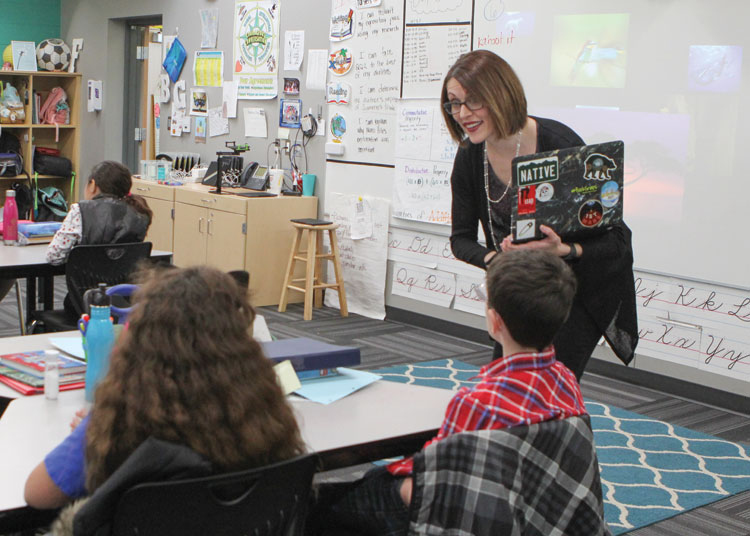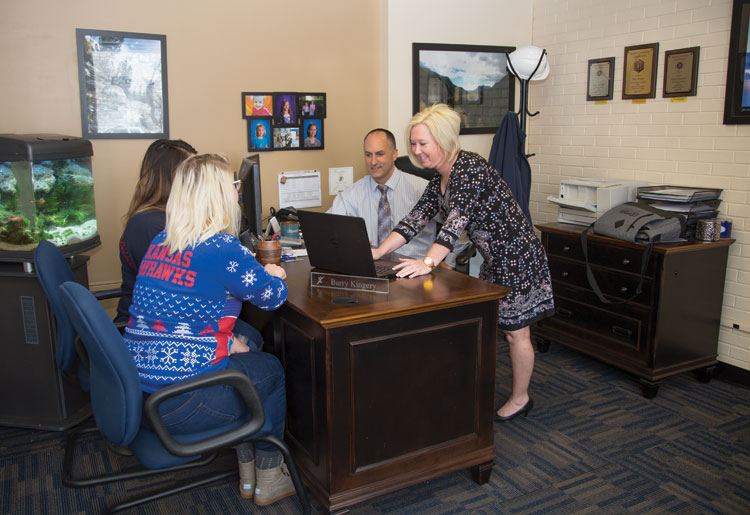Nearly every workplace these days has some sort of training required before and new employee enters the office.
| 2018 Q1 | story by Emily Mulligan | photos by Steven Hertzog

Assistant Superintendent Jerri Kemble teaches a training workshop at USD 497
With electronic badges and fingerprint scanning, most employees literally cannot walk into their workplaces these days without being trained first.
Training methods and topics have become a serious focus in workplaces for both technological and societal reasons. Lawrence teachers, orthodontic assistants and people who work in administrative positions and the skilled trades are trained extensively at the start of their jobs, and continuously throughout their tenure.

Kirsten Wondra Assistant Director for learning and technology instructs teachers on new computer software
Training Methods
Teacher training involves attending large group presentations, receiving one-on-one training from principals and learning coaches, and districtwide technology training on specific devices and curricula, explains Kirsten Wondra, assistant director for learning and technology at Lawrence Public Schools.
Orthodontic assistants at Ranjbar Orthodontics learn their skills from a designated trainer so that all assistants take the same approach to orthodontic appliance technique, technology and patient care, says Dr. N. Daniel Ranjbar. Equipment vendors also provide training to orthodontic assistants on how to operate new and advancing technologies.
Skilled trades people, once they have passed a skill test, are typically trained by a supervisor in workplace safety and operations. Some may also learn company regulations from corporate training presentations. Administrative staff in secretarial positions, medical billing and coding, and accounts payable/receivable positions learn from a supervisor or, often, from the person who held their job previously, says Kate Blocker, owner of Express Employment Professionals.

Mina Hill teaches through reading software to elementary students at Sunset Hill Elementary
New Hires
Whether the employee is new to the profession or starting a new position, he or she can expect to be trained extensively before diving in to the day-to-day work.
Teachers who are either brand new teachers or new to Lawrence Public Schools attend a four-day mass training event called “induction” in August before the school year begins, Wondra and Assistant Superintendent Jerri Kemble says.
“It’s funny because at induction, often, people want to focus on logistics like how to use their badge. But, we have precious little time with them, so we want to spend time on the longitudinal goals of what it means to work in Lawrence schools,” Wondra says.
“Personalized learning” is the district’s approach to teaching, so Kemble says much of induction is spent showing what personalized learning looks like and how to apply it to all aspects of the classroom. Curriculum, equity and diversity issues, school board goals, the state’s vision and standards, classroom behavior guidelines using the district’s CI3T (Comprehensive, Integrated, Three-Tiered) model and technology are all part of the big-picture goals that are covered at teacher induction.
Some items discussed include ID badges, I-9 tax forms, benefits training, information about school buildings and procedures, and the gradebook, Wondra explains. Guidance that is specific to each building, such as which doors to use and recess supervision protocol, are handled outside of induction.
“Building principals give them specific information for their school, including how the CI3T is applied, and then model it for the teachers, recognizing when they meet expectations. We try to model everything in how we conduct things with the teachers, showing what we expect in their classroom,” Wondra says.

Dr. N. Daniel Ranjbar, owner of Ranjbar Orthodontists. working on patients and training his staff in his Ranjbar offices.
New orthodontic assistants at Ranjbar Orthodontics spend up to six months “chairside,” observing and practicing patient evaluation and orthodontic appliance application, Dr. Ranjbar says.
He and his staff have developed a training syllabus since the office opened in 1994, and all new assistants’ training adheres to that syllabus.
“One person trains everybody-it’s like that saying, we are all ‘singing from the same hymnal.’ The one thing in our training is consistency; I can’t emphasize that enough,” Ranjbar says.
Once a new assistant is fully trained, all assistants are on equal ground in the office. There is no hierarchy or office manager, so everyone can contribute thoughts on how to continually improve the practice or make patients’ experiences better. Ranjbar likes hearing his 14 assistants’ perspectives and collaborating equally with them to do orthodontia.
“Anyone can straighten teeth, but I want to make a difference and be something positive in the lives of the kids who come in,” he says. “I have tried to hire like-minded people who are going to be the hardest on themselves in their work.”
New employees in the trades and industrial jobs typically take a tour of the job site to learn about the types of machines involved, job activities and safety procedures, Express Employment’s Blocker says. Mechanics usually start by performing tasks under the supervision of another mechanic. Typically, new HVAC employees go to a job site and talk to a trainer about how they would perform the repair or installation before taking it on. Lawn and landscape workers try out the equipment, including driving mowers.
Administrative new hires usually have learned software programs such as Microsoft Excel on their own, either from their personal experience or computer-based training like Express provides, Blocker explains. Their initial training could involve mastering any proprietary software, as well as learning the ropes of that particular workplace, usually one-on-one.

Brad Hemel of Hemel Electric trains apprentices on site.
Ongoing Training and Professional Development
Any parent with a child in school anywhere knows that teachers participate in professional development throughout the school year and throughout their careers.
Although professional development in Lawrence schools emphasizes many topics, including equity and classroom behavior management, a large amount of teachers’ ongoing training is about technology.
“Technology has been a big focus the past few years because we went to 1-to-1 devices for middle-schoolers and high-schoolers, and blended classrooms in the elementary schools. It now looks very different to walk into a classroom where each student has his or her school-issued device,” Kemble says.
Teachers not only have to learn how to operate and troubleshoot the iPads and laptops, they also have to integrate the devices seamlessly into the classroom and curriculum-and be ready for any new program or innovation right around the corner.
Learning coaches housed at each school offer the most ongoing support for teachers, Lawrence Public Schools’ Wondra says. They occasionally present to a school’s entire faculty about academic and behavioral techniques during the afternoons on early-release Wednesdays. Mostly, however, they instruct teachers as needed on applying personalized learning for the curriculum or offer tactics for a particular classroom’s behavioral dynamics. The learning coaches are both instructional mentors and personal mentors for teachers in their building.
There is also districtwide annual ongoing training for teachers in areas such as school safety and drills, suicide prevention, correct equity terminology, emergency safety interventions and HIPAA and FERPA privacy laws.
The majority of ongoing training at Ranjbar Orthodontics involves new technology or software. When the practice decides to adapt a new technology, such as the 3-D mouth scanner that generates a 3-D printout of each patient’s mouth, Dr. Ranjbar selects a point person to be the expert and trainer on that technology, and two secondary people to back up that person. The point people attend any necessary vendor or outside trainings on the technology and discuss how to implement it in the office, he says.
The lead trainer works one-on-one with each orthodontic assistant and Ranjbar to teach him or her how to use it, then supervises as each person tries it with patients. The other training team members are available for questions or troubleshooting as the technology is adopted.
Other training issues are discussed at the staff’s regular roundtable meetings and addressed as needed, Ranjbar explains.
“We make sure to remind everyone of all of the aspects of what we do here. Our meetings are a continual reminder of sticking to your fundamentals,” he says.
In industrial settings, Blocker explains that most training is administered by supervisors, and the topic with the most emphasis is safety.
“Reviewing safety procedures and what to do if there is an accident is so important; there is so much that can happen in a position like that, they have to be informed. And, the OSHA log is critical,” she says, referring to the federally mandated documentation for all workplace safety incidents and violations.

Express Em¬ployment Professionals owners Kate Blocker and Barry Kingery talk with clients
Trends in Training
Blocker says current events and the ever-changing national political environment have made it increasingly common for companies to hire outside trainers and speakers to come in and present on particular topics-from sexual harassment to race relations and beyond.
In 2017, Blocker partnered with the Lawrence Chamber of Commerce and brought outside speakers to Lawrence for a three-part series about generations in the workplace. Chamber members’ human resources staffs and higher-level managers learned about how to bridge workplace relations among baby boomers, Generation Xers and millennials, as well as how to adapt their workplaces and vocations to train and sustain millennials.
Another trend is to allow employees to do web-based training on their own time and off-site, in addition to training at the office, Blocker says. And training materials and approaches are evolving quickly to accommodate millennials, who have rarely, if ever, learned anything from a book of instructions and rules.
Most workplaces are starting to tailor the training to the learning method best suited to the individual. Blocker encourages her clients to ask the employee how he or she prefers to learn, and take it from there. Some learn by seeing, others learn by doing; and there are still people in the workforce who prefer to sit with a manual and read through the procedures.
Regardless of methods, it is clear employees have more than ever on their minds when they are at work, and workplaces are doing their best to understand that and support them in their job training.
“To be a teacher today, they have so much on their plate. There is no point of arrival-we never get to stop. We have to be a lifelong learner and learn with our kids, and let them teach us,” Lawrence Public Schools’ Kemble says.
